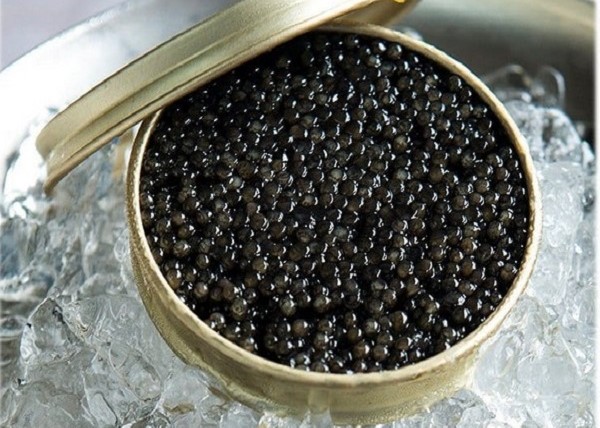salam man bahtam kazem

What is Caviar?
Perhaps the first question on anyone’s mind is: What is caviar?
In certain seas and oceans around the world, there are specific species of fish that live. These unique species produce rare and expensive eggs. These eggs are known as caviar.
Sturgeon fish belong to the order of Acipenseriformes, and there are various types of sturgeon.
The types of sturgeon include Beluga, Ossetra, Karaburun, Chalbash, Ship, Siberian, Sterlet, and Kaluga.
The natural habitats of sturgeon fish include the Caspian Sea, the Black Sea, Siberian seas, the Atlantic Ocean, and the Pacific Ocean.
Caviar comes in different and relatively limited varieties, such as Beluga, Asetra, Bery, Sevruga, and Sterlet. Kaluga is actually a Chinese variant of Beluga but is very similar to Asetra.
Due to its high price and rarity, caviar is often referred to as “black pearls.”
The history and practice of fishing and consuming caviar in Iran and the Caspian Sea region dates back to around the 4th century BC. At that time, due to the lack of preservation methods for the warmer seasons, this seafood was salted to preserve it.
Caviar is generally round or occasionally oval in shape, with colors ranging from white, black, gray, to light and dark brown.
The size of the caviar grains is typically between 2.2 to 3.9 millimeters.
This food is extremely nutritious, containing a variety of minerals, amino acids, proteins, fatty acids, and vitamins, which contribute to its high nutritional value.
This high nutritional content also leads to numerous health benefits.
Consuming caviar helps in the treatment and prevention of various diseases.
Due to changes in taste when caviar comes into contact with metal, it should be served in non-metallic containers.
Experts recommend consuming it at breakfast, as the body absorbs it better during the early hours of the day.
Depending on individual consumption, about 20 to 40 grams of caviar can be eaten per serving.
It can also be paired with toast, vegetables, butter, boiled eggs, mashed potatoes, and more.
This valuable product should be stored away from sunlight and in the refrigerator. It should always be kept in its original container with the lid sealed.
Caviar is available in both wild (marine) and farmed types.
Iran’s marine caviar export is prohibited based on international agreements regarding the Caspian Sea.
Farmed caviar samples are of higher quality and price.
The main export grades include Imperial, Royal, Grade 1, and Grade 2.
The price of each type of caviar differs. Beluga is the most expensive, while Bery is the least expensive.
Original Iranian caviar is mainly available in Beluga varieties.
The excellence and quality of Beluga are defined by the taste, size, and consistency of the grains.
Despite the continuous devaluation of the rial, direct purchases by people from outside of Iran are very cost-effective.
Various sales centers and representatives operate across the country, with one of the most prominent and best-known companies in this field being “Paradise Caviar.”
This company offers the highest quality products at the most reasonable prices, and they are the only group providing free cold box delivery.
International orders are sent via CIF or through customs.
For more information and to place your order, please contact us now.

What is Caviar Made From?
Caviar is derived from a type of fish known as sturgeon.
These aquatic creatures come in various species, and each of these species produces a specific type of caviar.
The species include Beluga, Ossetra, Karaburun, Chalbash, Ship, Siberian, Sterlet, and Kaluga.
Their natural habitats include the Caspian Sea, the Black Sea, Siberian seas, the Atlantic Ocean, and the Pacific Ocean.
Beluga is the largest, while Siberian sturgeon is the smallest among sturgeon species.
The consumption of caviar in Iran dates back to the 4th and 5th centuries BC.
Due to its high perishable nature and the lack of refrigeration, it was traditionally salted for preservation.
The origin of the name “caviar” is not entirely clear, though there are various speculations that it may be derived from Latin or Sanskrit.
What is Caviar and What is it Known For?
Caviar is famous for being known as “black pearls.”
This name comes from its high nutritional value and its significant monetary worth.
Its rarity, coupled with supply and demand dynamics, directly contributes to this association with pearls.
Caviar is typically in the form of dark-colored grains, and it is generally round and spherical.
There are rare exceptions where the grains are oval-shaped.
Aside from the diamond variety, the other types fall within darker color ranges, which is why it is often referred to as “black pearls.”
What is Caviar and How is it Obtained?
Caviar is the undeveloped and unfertilized eggs of sturgeon fish.
There are various types of sturgeon, including Beluga, Ossetra, Karaburun, Chalbash, Ship, Siberian, Sterlet, and Kaluga.
These sturgeon species inhabit different shared and unique ecosystems. These habitats include the Caspian Sea, the Black Sea, Siberian seas, the Atlantic Ocean, the Pacific Ocean, and the Atlantic Ocean.
The eggs inside the sturgeon’s belly take several years (ranging from 5 to 16 years, depending on the species) to reach the harvesting stage.
Caviar is extracted using two methods: cesarean and non-cesarean.
In the cesarean method, after the eggs are harvested, the sturgeon is returned to its habitat or farm for further breeding.
In the non-cesarean method, the sturgeon’s meat is sold either frozen or canned.
The Siberian sturgeon reaches harvesting maturity in about 5 years, while the Beluga sturgeon takes between 8 to 16 years.
This explains the significant differences found among various types of caviar.